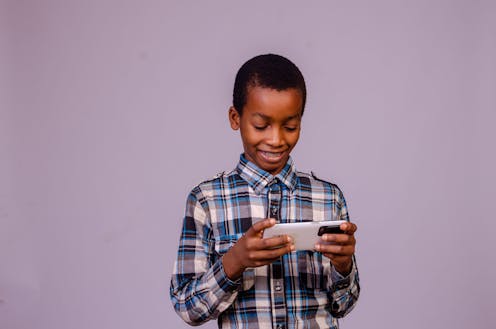
Literacy changes lives: in Unesco’s words, it “empowers and liberates people, … reduces poverty, increases participation in the labour market and has positive effects on health and sustainable development”.
But in South Africa, 8 out of 10 children cannot read for meaning by the end of their third school year.
During the first three years of their education, South African children receive schooling in one of the 11 written official languages. Generally, this means being taught in their home language.
Then, at the beginning of grade 4 – when most learners are about 10 years old – English becomes the language of instruction. Learners are expected to be literate in both English and their home language by this time. In reality, they are not literate in any language.
The problem is partly caused by the fact that South Africa is, in many respects, a resource-scarce country, especially as it concerns indigenous languages. Even a language such as isiZulu, with 15 million home language speakers, has a dearth of language education resources. The situation is even worse for smaller languages, such as isiNdebele, with just over 1 million home language speakers.
In such an environment, where it’s not easy to acquire literacy, the innovative and creative use of technology offers new ways of tackling this strategic challenge. This is what our Ngiyaqonda! project aims to do. “Ngiyaqonda” is an isiZulu word which means “I understand”.
The project centres on a mobile application to support literacy development. The app’s goal is to provide a rich digital environment, involving speech and text technology, in which learners build grammatically correct sentences based on audio prompts generated via synthetic voice technology – a first for isiZulu.
The initial focus is on the learner’s home language (it’s currently being piloted with grade 3 isiZulu-speaking learners at a school in Soweto, Johannesburg). English is introduced gradually as a target language. The language and speech technology has been developed to provide linguistic accuracy and is grounded in teaching principles.
Large language models
Technology, especially the employment of language technology in the education domain, is not a silver bullet. Its use must be carefully considered. This means having a clear idea of the expectations and limitations of possible solutions. In other words, what factors should be considered when using technology in support of literacy development for young children?
Read more: Mobile app offers new learning tools for anatomy students. But tech isn't a silver bullet
A multimodal approach is an obvious starting point: children can talk long before they can read and write. Employing speech technology along with text technology helps to bridge the gap from oral competency in a language to written competency. Grammatical correctness and the appropriate use of suitable vocabulary are essential, too.
ChatGPT has changed popular perceptions of what is possible in modelling languages using computers. The program uses large language models, which predict how words occur together in a language. This requires massive amounts of data. But there’s a problem when dealing with a resource-scarce language like isiZulu: there simply isn’t enough data available to train a model that is reliable enough to meet the requirements we’ve mentioned. And isiZulu’s linguistic characteristics, like the complex internal structure of its words, could severely affect the grammatical accuracy of such models if trained on insufficient data.
Computational grammars
That’s where computational grammars come in. These are structured sets of rules that describe how words occur in a language. Instead of making predictions based on previously seen data, computational grammars model the grammar of the language in a more direct way, allowing a larger degree of control over accuracy.
Our approach involves the use of such grammars for isiZulu and English and covers both languages’ major linguistic structures, as well as curriculum-based vocabulary. They have been designed to generate thousands of grammatically correct sentences that meet the teaching and learning requirements of repetition and novelty.
Read more: South Africa's reading crisis: 5 steps to address children's literacy struggles
These sentences function as the language content of the speech-enabled mobile application. The application uses synthetic voice technology (also known as text-to-speech) to read aloud the automatically generated sentences in either isiZulu or English. The computational grammars act as a predictive text engine that allows users to recreate the prompt sentences word by word. An area of the screen is dedicated to displaying words as options for building the sentence. Users can select words by dragging them into the sentence itself; with each correct selection, new options are generated.
Lessons
In the earlier lessons, the application focuses on the task of decoding. This is a mental process and an essential component of reading in which sequences of letters must be associated with their corresponding sounds to form words. At this stage, lessons are monolingual.
For example, in the first lesson, a learner might encounter the sentence
UVusi ufuna isikhindi ediloweni (Vusi searches for his pants in the drawer).
This would be read aloud by the text-to-speech in isiZulu. The learner must fit the words they see to the sounds they hear.
Later lessons are multilingual and focus at the same time on reading for meaning and learning a target language. For most learners, the target language is English. Learners listen to sentences in one language and must reproduce a translation textually.
The app currently includes nine lessons. We plan to significantly expand this soon.
Pilot project
The purpose of the pilot study is to establish whether the app makes a measurable difference in learners’ ability to read and compose sentences. It is used during scheduled reading periods and is meant to complement the educator’s existing teaching approach.
Read more: Learning to read is a journey: a study identifies where South African kids go off track
We are fortunate to be collaborating with a school and team of educators who have embraced innovation as an aid to improving their learners’ outcomes. The results of the study are expected towards the end of 2023 and will inform subsequent studies in 2024.
Preliminary results indicate that both the teachers and the learners are benefiting from using the app in the classroom. The teachers say they appreciate its multimodal aspect, which allows the children to learn independently; the children are excited to use it during their reading lessons.
Laurette Marais works for the CSIR. This work has been funded by the South African Department of Sport, Arts and Culture.
Laurette Pretorius consults to the CSIR.
This article was originally published on The Conversation. Read the original article.







